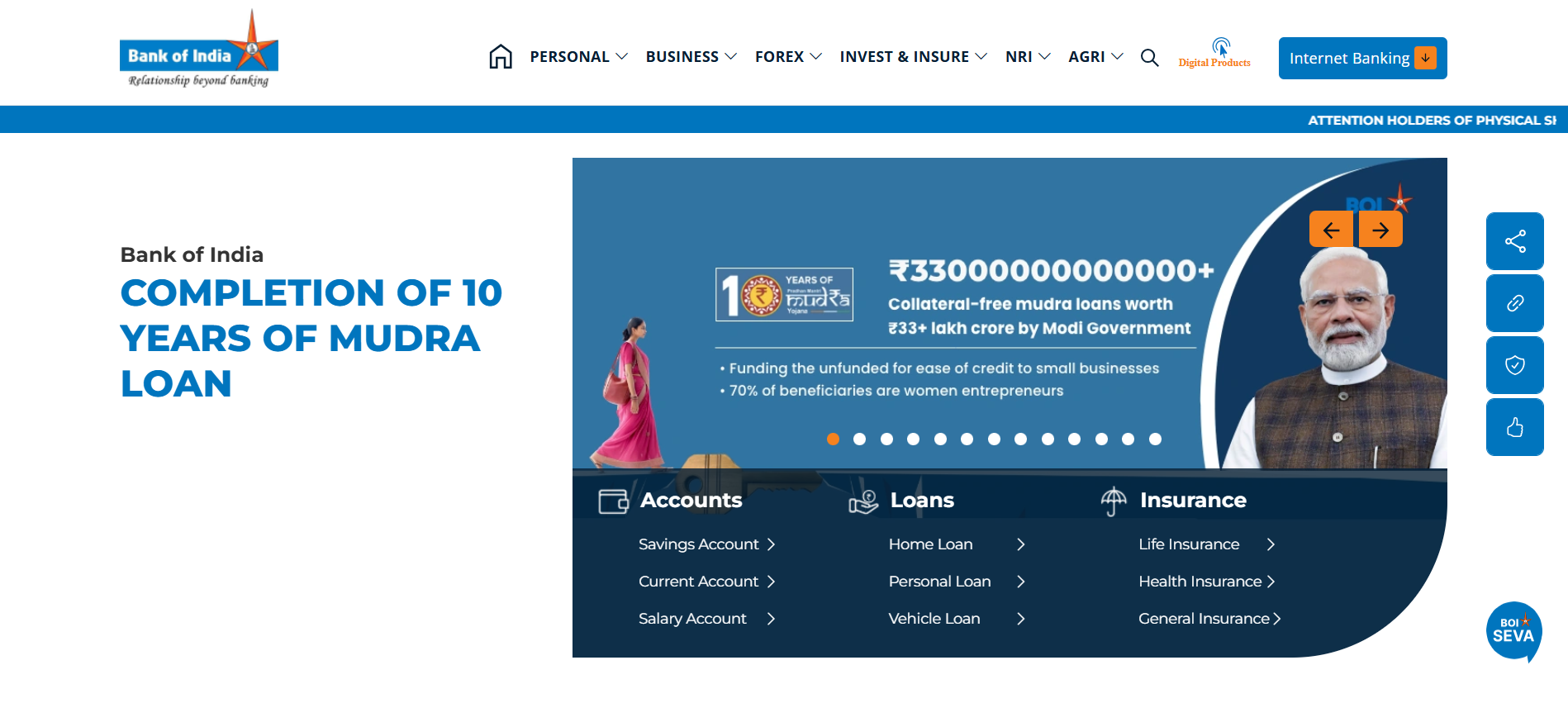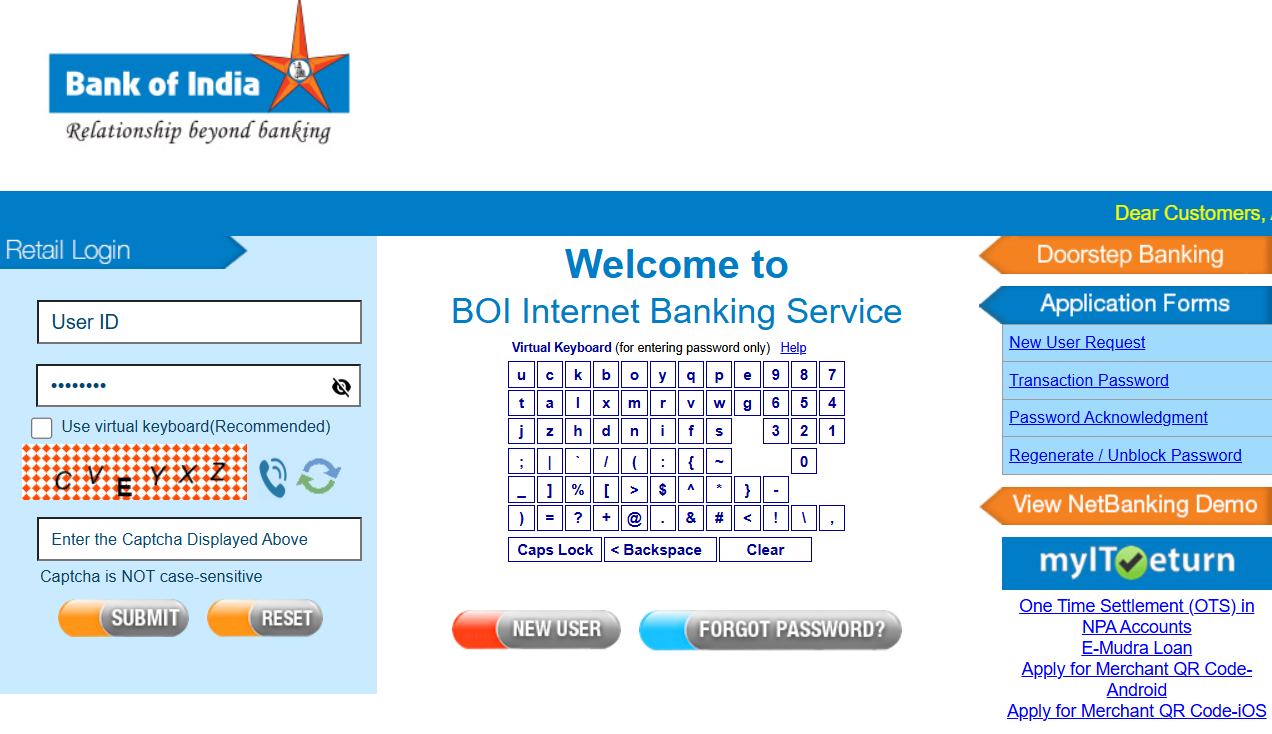Bank of India understands that property ownership serves two vital functions: securing a comfortable home and enabling a promising investment. By financing up to 90% of your property’s cost at competitive rates starting at 8.35% p.a., BOI provides a reliable, convenient path to homeownership—equally appealing to residents and investors alike.
Bank of India Home Loan Interest Rates by Employment
Bank of India adjusts home loan interest rates based on whether you’re salaried, self-employed, or have a professional practice. These rates reflect current market conditions and are influenced by factors like your CIBIL score. Below is a quick look at how your employment type can influence your rate.
Bank of India Home Loan Interest Rates for Salaried Employees
| CIBIL Score | Fixed Interest Rates | Floating Interest Rates |
|---|---|---|
| 825 and Above | 10.60% p.a. onwards | 8.40% p.a. onwards |
| 800 – 824 | 10.60% p.a. onwards | 8.50% p.a. onwards |
| 740 – 799 | 10.60% p.a. onwards | 8.70% p.a. onwards |
| 725 – 759 | 10.70% p.a. onwards | 8.80% p.a. onwards |
| 675 – 724 | 10.80% p.a. onwards | 9.55% p.a. onwards |
| Below 624 (For Women Beneficiary) | 11.90% p.a. onwards | 10.65% p.a. onwards |
| Below 624 (For Others) | 11.95% p.a. onwards | 10.70% p.a. onwards |
| -1/ 0 | 10.90% p.a. onwards | 8.80% p.a. onwards |
Bank of India Home Loan Interest Rates for Self Employed Individuals
| CIBIL Score | Fixed Interest Rates | Floating Interest Rates |
|---|---|---|
| 825 and Above | 10.60% p.a. onwards | 8.40% p.a. onwards |
| 800 – 824 | 10.60% p.a. onwards | 8.50% p.a. onwards |
| 740 – 799 | 10.60% p.a. onwards | 8.70% p.a. onwards |
| 725 – 759 | 10.70% p.a. onwards | 8.80% p.a. onwards |
| 675 – 724 | 10.80% p.a. onwards | 9.55% p.a. onwards |
| Below 624 (For Women Beneficiary) | 12.05% p.a. onwards | 10.80% p.a. onwards |
| Below 624 (For Others) | 12.10% p.a. onwards | 10.85% p.a. onwards |
| -1/ 0 | 10.90% p.a. onwards | 8.80% p.a. onwards |
Check Out: Bank of India Home Loan EMI Calculator
Bank of India All Schemes Home Loan Interest Rates
Bank of India offers multiple home loan schemes, each with its own interest rate structure and features. Here’s an overview of the current rates for various SBI schemes.
| Home Loan Type | Home Loan Interest Rates |
|---|---|
| BOI Star Home Loan | 8.35% p.a. onwards |
| BOI Star Diamond Home Loan | 8.35% p.a. onwards |
| BOI Star Smart Home Loan | 8.35% p.a. onwards |
| BOI Star Pravasi Home Loan (NRI Home Loan) | 8.35% p.a. onwards |
| BOI Star Top Up Loan | 8.35% p.a. onwards |
| BOI Star Home Loan – Furnishing | 8.35% p.a. onwards |
Suggested Read: Bank of India Home Loan Documents
All Schemes Offered by Bank of India: A Detailed Overview
Bank of India has a range of home loan schemes catering to diverse needs, from ready-to-move properties to under-construction projects. Read on to find the best fit for your housing requirements.
BOI Star Home Loan (General Home Purchase Loan)
The Bank of India Star Home Loan provides flexible financing and dedicated support to help homebuyers achieve their dream. With competitive interest rates, minimal paperwork, and personalized assistance, it ensures a smooth journey from application to ownership. You can benefit from tailored repayment options and ongoing guidance.
Additional Benefits
- OD Facility at the same interest rate of Home Loan up to Rs. 2 Crore. No processing fees.
- Loan facility for purchasing Solar PV @ROI Home Loan
- Step up/Step Down EMI facility
- Insurance premium is a mandatory component
- Free accidental insurance coverage up to limit Rs. 5.00 Crores
| Features | Details |
|---|---|
| Tenure | 30 years |
| Rate of Interest | 8.35% p.a. onwards |
| Moratorium Period | 36 Months |
BOI Star Diamond Home Loan (HNI Home Loan)
Bank of India Star Diamond Home Loan offers an exclusive home loan solution for buying premium residential properties in prime metropolitan areas. This specialized offering ensures minimal documentation, competitive interest rates, and a streamlined online application process—all backed by the reliability and legacy of Bank of India.
| Features | Details |
|---|---|
| Tenure | 30 years |
| Rate of Interest | 8.35% p.a. onwards |
| Loan Amount | Above ₹7.5 Crore |
| Moratorium Period | 36 Months |
BOI Star Smart Home Loan
Bank of India Star Smart Home Loan is available to customers holding salary accounts, as well as existing and new savings/current account holders of the bank. Through this facility, individuals can purchase a plot and construct a house, provided construction commences within five years from the loan disbursement date.
| Features | Details |
|---|---|
| Tenure | 30 years |
| Rate of Interest | 8.35% p.a. onwards |
| Minimum Loan Amount | Salaried: ₹5 lakhsSelf Employed:₹10 lakhs |
| Moratorium Period | 36 Months |
BOI Star Pravasi Home Loan (NRI Home Loan)
Bank of India’s Star Pravasi Home Loan lets NRI borrowers buy a plot and construct a home on it. It also supports balance transfer from existing lenders, home furnishing, installation of solar PV systems, as well as enhancements, extensions, and renovations of existing residential properties.
- OD facility for entire limit/outstanding balance at 0.50 above ROI of Home Loan
| Features | Details |
|---|---|
| Tenure | 30 years |
| Rate of Interest | 8.35% p.a. onwards |
| Moratorium Period | 36 Months |
BOI Star Top Up Loan (Home Loan Top Up)
Bank of India’s Star Top Up Loan provides existing home loan customers with an additional loan, allowing them to meet various financial needs without undergoing a separate, lengthy lending process. This offering ensures quick access to extra funds while maintaining the convenience and stability of an established home loan relationship.
| Features | Details |
|---|---|
| Tenure | Remaining repayment period of your existing home loan |
| Rate of Interest | 8.35% p.a. onwards |
| Moratorium Period | 36 Months |
BOI Star Home Loan – Furnishing (Renovation and Extension)
Bank of India Star Home Loan – Furnishing provides additional financing for renovating and enhancing your home.
- Mortgage is waived up to ₹5 Lakh
| Features | Details |
|---|---|
| Tenure | 10 years |
| Rate of Interest | 8.35% p.a. onwards |
| Maximum Loan Amount | Up to 15% of Home Loan |
| Moratorium Period | Up to commencement of housing loan repayment |
Suggested Read: Impact of Home Renovation on Home Insurance
How Does Reserve Bank of India (RBI) Repo Rate Impact Home Loan Interest Rates?
The repo rate is the interest rate at which the RBI lends short-term funds to commercial banks. It acts as a benchmark for the economy, influencing liquidity and credit availability. For example, a lower repo rate reduces banks’ borrowing costs, encouraging them to lend more.
Direct Impact on Home Loan Rates
- Rate cuts reduce borrowing costs : When the RBI lowers the repo rate, banks can borrow funds at cheaper rates, potentially reducing home loan interest rates
- Example from 2025 : In February 2025, the RBI reduced the repo rate by 25 basis points to 6.25%, followed by another cut to 6%.These moves aimed to stimulate economic growth by making loans more affordable.
Transmission to Borrowers
- Partial or delayed pass-through : Banks may not immediately pass the full benefit of repo rate cuts to borrowers. For instance, after the February 2025 cut, lenders gradually adjusted home loan rates, with potential EMIs dropping by ₹500–₹1,000 per lakh
- Dependence on bank policies : Banks factor in operational costs, profit margins, and market competition when adjusting rates. For example, SBI and HDFC reduced rates to 8.25–8.5% post-February 2025 cuts, but smaller lenders might lag.
Key Outcomes for Home Loan Borrowers (2025)
- Lower EMIs : A 25-basis-point repo rate cut could reduce monthly EMIs for existing and new borrowers if banks adjust their rates
- Potential sub-8% rates : Analysts suggest home loan rates might dip below 8% in 2025 due to cumulative repo rate reductions, benefiting first-time buyers and refinancers
Inflation and Repo Rate Dynamics
- High inflation : The RBI typically raises the repo rate to curb inflation, increasing home loan costs.
- Low inflation : Falling inflation allows the RBI to cut rates, easing the burden on borrowers.
Suggested Read: When Does Your Home Become a Non Performing Asset?
How to Get Lowest Bank of India Home Loan Interest Rates?
- Maintain a high credit score to qualify for lower interest rates
- Compare different loan schemes and negotiate for better terms
- Opt for a shorter loan tenure if possible to reduce interest burden
- Leverage your existing relationship with the bank for preferential rates
- Make a higher down payment to lower your overall interest cost
Read More: Bank of India Home Loan Eligibility Checklist
Types of Home Loan Interest Rates
| Interest Rate Type | Definition | Pros | Cons |
|---|---|---|---|
| Fixed | Rate remains constant throughout a predetermined period or entire tenure. | – Predictable EMIs for budgeting – Protection against rising interest rates | – Typically, higher rates compared to floating – No benefit if market rates go down |
| Floating (Variable) | Linked to market benchmarks (e.g., Repo Rate, MCLR) and changes over time | – Often cheaper when rates fall – Can partly or fully prepay with lower penalties | – EMIs fluctuate with market conditions – Costs may rise if rates increase |
| Hybrid | Combination of fixed and floating phases. | – Stability in the initial fixed period – Potential cost savings in the variable phase | – Transition from fixed to floating can carry uncertainties – May incur a shift-related fee |
Suggested Read: All Banks Home Loan Interest Rates 2025
Factors Affecting Bank of India Home-Loan Interest Rate
| Factor | How It Affects the Interest Rate |
|---|---|
| Credit score & repayment history | Higher credit scores & consistent repayments often lead to lower rates |
| Loan amount & tenure | Larger loan amounts or extended tenures can raise rates due to increased risk |
| Type of interest rate (fixed or floating) | Floating rates fluctuate with market changes; fixed rates remain constant but can be higher initially |
| Market & repo rate trends | Rates typically rise or fall in line with the central bank’s policy decisions |
| Employment & income stability | Steady job & robust income can fetch more favorable rates |
| Loan-to-value (LTV) ratio | A lower LTV (larger down payment) signals reduced risk, helping secure lower rates |
| Banking relationship | Good track record or existing relationship with the bank may result in preferential rates |
How are Home Loan Interest Rates Calculated?
Home loan interest rates typically start with a benchmark – for example, the repo-linked lending rate (RLLR) or MCLR. Your bank sets its own spread above this reference to cover operational and credit-related risks. That margin, in turn, depends heavily on your credit score, income stability, loan amount, and the overall risk perceived by the lender.
In addition, economic policies (like changes in the repo rate announced by the central bank) can cause benchmark rates to move up or down, directly influencing what you end up paying over time.
Suggested Read: RLLR vs. MCLR vs. PLR
How to Obtain the Bank of India Home Loan Interest Certificate?
- Visit the official website of Bank of India.

- Login using your credentials (user ID and password).

- Your browser will be redirected to the dashboard.
- Click on the Enquiries tab.
- Choose Home Loan Provisional Certificate.
- Download, print, or view the statement.
Suggested Read: Repo Rates vs. Home Loan Rates
Will Home Loan Interest Rates Go Down in 2025?
Yes, home loan interest rates in India have already started declining in 2025, following the Reserve Bank of India’s (RBI) decision to cut the repo rate by 25 basis points (bps) on April 9, 2025 .
This reduction, combined with a similar cut in February 2025, brings the cumulative repo rate decrease to 50 bps this year, lowering the rate from 6.25% to 6% .
These cuts directly impact floating-rate home loans linked to the repo rate, which most banks use as their external benchmark.
EMI vs. Tenure Reduction: Which Saves More?
Banks typically shorten the loan tenure while keeping EMIs unchanged during rate cuts. Borrowers can opt for this or request an EMI reduction.
For example, a Rs 50 lakh loan at 8.25% (post-February cut) will now cost 8%, lowering monthly EMIs by Rs 777 (from Rs 42,603 to Rs 41,826).
- Lower EMIs : Immediate cash flow relief (e.g., saving Rs 777/month). Total interest saved over 20 years: ~Rs 1.85 lakh .
- Shorter Tenure : Retaining the original EMI shaves 10 months off the loan term, saving ~Rs 4.36 lakh in interest. Experts recommend this option for 234% higher savings compared to EMI cuts.
Suggested Read: What is Reverse Repo Rate?
Get a Home Loan
with Highest Eligibility
& Best Rates

Secure the Lowest Bank of India Home Loan Interest Rates with Credit Dharma
Buying a home is a big step. Getting a home loan can be hard, but we make it easy. Choosing Credit Dharma for your home loan simplifies this process. We offer expert advice and personalized assistance to make everything hassle-free. You’ll receive timely updates on your loan application and disbursement progress.
From the initial application to the final disbursement, we provide comprehensive support. Enjoy clear and honest communication at every stage, with no hidden surprises.
Frequently Asked Questions
Bank of India home loan interest rates typically start from 8.35% p.a. However, these rates can vary based on factors such as the loan amount, repayment tenure, the applicant’s credit history, and whether the interest rate is fixed or floating.
Yes, Bank of India is considered a reputable and reliable option for obtaining a home loan. As one of India’s largest public sector banks, BOI offers the lowest home loan interest rates with flexible repayment options, and transparent fees and charges.
Bank of India generally allows applicants between the ages of 18 and 70 years to apply for a home loan. Here’s a typical age-related guideline:
-Minimum Age: 18 years at the time of loan disbursement.
-Maximum Age: 70 years at the end of the loan tenure.
A fixed interest rate offers stable EMIs throughout the loan tenure, while a floating interest rate fluctuates based on market conditions, potentially lowering costs if rates drop. For Bank of India home loans, choose a fixed rate for certainty or floating for potential savings. Evaluate based on your risk tolerance.

 HDFC Home Loan
HDFC Home Loan SBI Home Loan
SBI Home Loan
